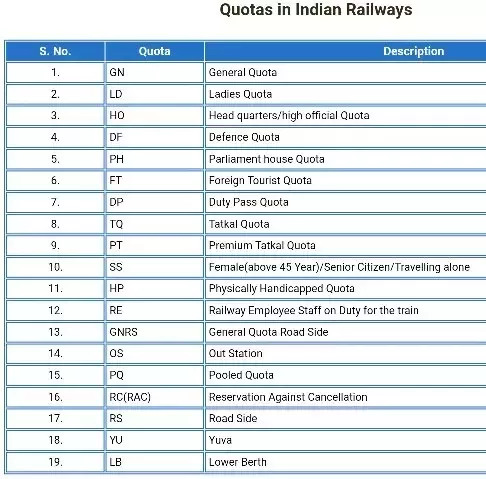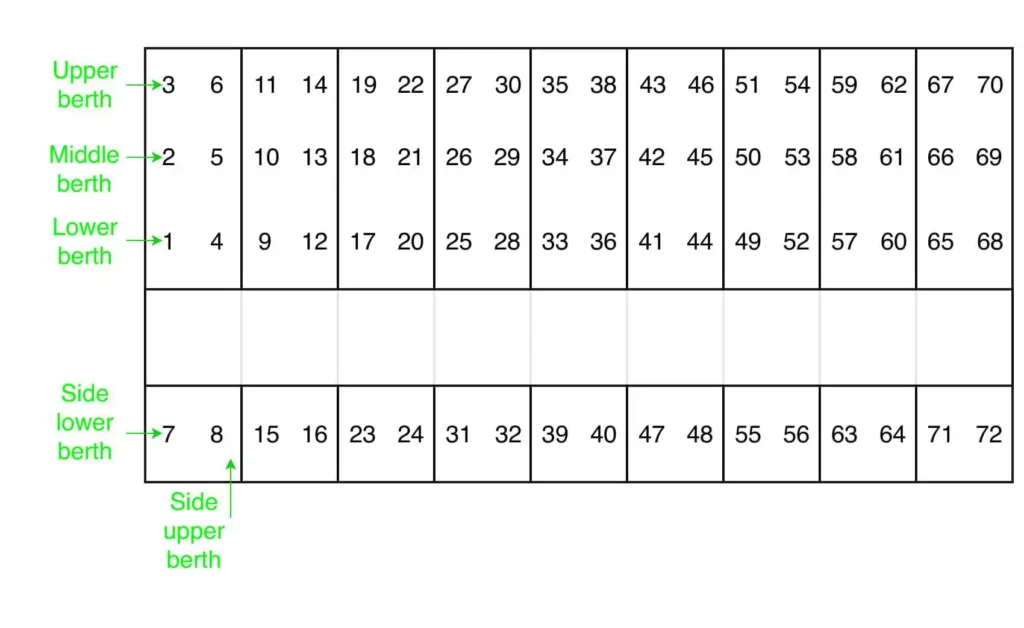Learn with Quick Guide to Train Reservation Seat Codes and Quotas
For millions of people worldwide, taking the train is an essential aspect of daily life. Understanding the nuances of train reservation seat descriptions can significantly improve your travel experience, whether it’s for the everyday commute to work or a long-awaited holiday. In this thorough guide, we’ll delve into the specifics of the different symbols and descriptions connected with train reservations so you may travel smoothly and with confidence. So let’s start this educational journey on Train Reservation Seat Codes and Quotas.
Decoding the Seat Availability Codes
Before we dive into the specific seat descriptions, let’s decode the legends commonly found on train tickets:
1. CAN / MOD – Cancelled or Modified Passenger
This symbol indicates that the passenger has either canceled their reservation or made modifications to it.
You May Love To Read
2. CNF / Confirmed – Confirmed Reservation
When you see “CNF” on your ticket, it means that your reservation has been confirmed. However, the coach/berth number will be available only after chart preparation.
3. RAC – Reservation Against Cancellation
RAC signifies that you have a reservation but are on a waiting list for a confirmed berth. You will be allocated a seat if there are cancellations.
4. WL # – Waiting List Number
If your ticket displays “WL” followed by a number, it indicates your position on the waiting list. A lower number increases your chances of getting a confirmed berth.
5. RLWL – Remote Location Wait List
RLWL is a waitlist specific to intermediate stations between the origin and destination. It has a separate quota and can be challenging to get confirmed.
6. GNWL – General Wait List
The GNWL is the general waiting list for passengers traveling between the origin and destination stations. It usually has a better chance of confirmation compared to RLWL.
7. PQWL – Pooled Quota Wait List
PQWL is a waitlist against pooled quotas, which are earmarked for specific groups. It’s crucial to understand the rules associated with pooled quotas for your journey.
8. REGRET/WL – No More Booking Permitted
If your ticket displays this message, it means that no more bookings are allowed for this particular train.
9. RELEASED – Ticket Not Cancelled but Alternative Accommodation Provided
“RELEASED” indicates that your original ticket has not been canceled, but you have been provided with an alternative accommodation.
You May Love To Read
10. R# # – RAC Coach Number Berth Number
When you see “R” followed by two numbers, it means you have a Reservation Against Cancellation with assigned coach and berth numbers.
11. WEBCAN – Railway Counter Ticket Passenger Cancelled through Internet
WEBCAN indicates that a passenger has canceled their railway counter ticket through the Internet.
12. WEBCANRF – Railway Counter Ticket Passenger Cancelled through Internet and Refund Collected
Similar to WEBCAN, but in this case, the passenger has also collected their refund.
13. RQWL – Roadside Quota Waitlist
RQWL is a waitlist against the roadside quota, which is specific to certain locations. It’s essential to check the availability of this quota for your journey.
14. DPWL – Duty Pass Waitlist
DPWL is a waitlist for passengers holding duty passes. This quota is reserved for railway staff and their families.
15. TQWL – Tatkal Quota Waitlist
TQWL is a waitlist against the Tatkal quota, which is designed for passengers who book their tickets under the Tatkal scheme. It can be challenging to get confirmed from this list.
16. NT – Passenger Not Turned Up
“NT” indicates that a reserved passenger did not turn up for the journey.
Understanding Your Train Reservation
Now that we’ve deciphered the legends, let’s put this knowledge to practical use. When you book a train ticket, it’s essential to understand what your reservation status means. Here’s a breakdown:
- Confirmed Reservations (CNF): Congratulations, your seat is confirmed, and you can check your coach and berth details after chart preparation.
- Reservation Against Cancellation (RAC): While not confirmed, you have a seat, and there’s a good chance you’ll get a berth as other passengers cancel.
- Waiting List (WL): Your ticket is on the waiting list. The lower your WL number, the better your chances of confirmation.
- Remote Location Wait List (RLWL): This waitlist is for intermediate stations and can be challenging to clear.
- General Wait List (GNWL): This is the general waiting list for passengers traveling from the origin to the destination.
- Pooled Quota Wait List (PQWL): Your ticket is on the waitlist against a pooled quota, so it’s crucial to understand the specific rules for your journey.
- Reservation Against Cancellation with Coach and Berth Number (R# #): You have a RAC ticket with allocated coach and berth numbers.
Different Types of Seat Quota on Train Reservations
Understanding these different seat quotas can greatly benefit passengers when booking train tickets. It’s essential to be aware of the eligibility criteria and availability of each quota to make the most suitable reservation for your journey.

1. GN – General Quota
The General Quota is the most common quota available for train reservations. It is open to the general public and does not have any specific eligibility criteria. Passengers who book tickets under this quota are allotted seats on a first-come, first-served basis. The majority of train tickets are reserved under the General Quota.
2. TQ – Tatkal Quota
The Tatkal Quota is designed to provide passengers with the option to book tickets at a short notice. Tatkal tickets can be booked one day before the scheduled departure of the train. However, Tatkal bookings come with a higher fare and are subject to availability.
3. PT – Premium Tatkal Quota
The Premium Tatkal Quota is similar to the Tatkal Quota but offers greater flexibility and faster booking options. Premium Tatkal tickets can be booked online and are subject to dynamic pricing, meaning the fare increases as more seats are booked.
4. LD – Ladies Quota
The Ladies Quota is exclusively reserved for female passengers traveling alone or with other females. It ensures the safety and comfort of female travelers during their journey.
5. SS – Lower Berth Quota
The Lower Berth Quota is primarily for senior citizens and physically handicapped passengers. It ensures that these individuals are allocated lower berths for ease of access and comfort during the journey.
6. HP – Physically Handicapped Quota
The Physically Handicapped Quota is specifically reserved for passengers with physical disabilities. It provides accessible seating and other facilities to accommodate their needs.
7. HO – Headquarters/High Official Quota
The Headquarters/High Official Quota is reserved for government officials and high-ranking individuals. These seats are allocated based on specific guidelines and are not available to the general public.
8. PH – Parliament House Quota
The Parliament House Quota is reserved for members of parliament and is used for official parliamentary duties. These seats are not available for public booking.
9. DF – Defence Quota
The Defence Quota is reserved for armed forces personnel and their families. It ensures that members of the armed forces have access to train reservations.
10. FT – Foreign Tourist Quota
The Foreign Tourist Quota is designed for foreign tourists visiting India. It provides a certain number of seats on select trains for foreign travelers.
11. DP – Duty Pass Quota
The Duty Pass Quota is reserved for railway employees traveling on duty. It allows railway staff to book tickets for official travel.
12. YU – Yuva Quota
The Yuva Quota is aimed at young passengers between the ages of 15 and 45. It offers discounted fares to encourage more youth to travel by train.
Train Seat Types
Indian Railways offers a variety of train seat types, each with its own advantages and disadvantages. Here are the most common types:

- Air-Conditioned Executive Chair Car (EC): Luxurious seats with air conditioning and luggage racks.
- Air-Conditioned First Class (1A): Sleeper compartments with 2 or 4 berths, lockable doors, air conditioning, and reclining seats.
- Air-Conditioned Two-Tier Class (2AC): Open-plan compartments with 6 berths (2 lower, 2 middle, 2 upper), air conditioning, and reclining seats.
- Air-Conditioned Three-Tier Class (3AC): Open-plan compartments with 6 berths (2 lower, 2 middle, 2 upper), air conditioning, and reclining seats.
- First Class (FC): Similar to 1A class but more luxurious and with fewer seats.
- Chair Car (CC): Non-air conditioned reclining seats, suitable for short-distance travel.
- Sleeper Class (SL): Non-air conditioned berths, the most economical way to travel by train.
- 2nd Seating (2S): Non-air conditioned bench seats, the cheapest option for short-distance train travel.
Conclusion
Understanding train reservation seat descriptions is essential for a hassle-free journey. It helps you know whether your seat is confirmed or if you’re on a waiting list. Remember that patience is key, and there’s often movement on waiting lists as other passengers cancel their reservations.
Now, armed with this knowledge, you can embark on your train journey with confidence, knowing exactly what your reservation status means.
Frequently Asked Questions (FAQs)
What should I do if my ticket is on the waiting list (WL)?
If your ticket is on the waiting list, you can monitor its status regularly. As other passengers cancel their reservations, your chances of getting a confirmed berth improve.
Is there a difference between RLWL and GNWL?
Yes, RLWL is specific to intermediate stations, while GNWL is the general waiting list for passengers traveling between the origin and destination.
Can I travel with an RAC ticket?
Yes, you can travel with an RAC ticket. You will be provided with a seat, and there’s a good chance of getting a berth if other passengers cancel.
What is the Tatkal Quota Waitlist (TQWL)?
TQWL is a waitlist for passengers who book their tickets under the Tatkal scheme. It can be challenging to get confirmed from this list.
What does “RELEASED” mean on my ticket?
“RELEASED” indicates that your original ticket has not been canceled, but you have been provided with an alternative accommodation.






















